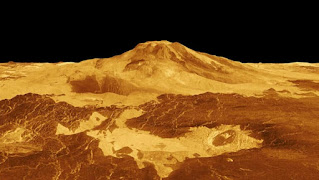Magellan spacecraft captured the topology of Venus' surface from 1990 to 1992. It remains uncertain, however, if the planet is currently experiencing active volcanism. A recent image taken by NASA showcases three impact craters on the surface of Venus.
For the first time ever, scientists have obtained geological proof of recent volcanic activity on the surface of Venus utilizing archival radar images taken in the 1990s by NASA's Magellan mission. These images have been pored over for more than 30 years.
In a period of less than twelve months, a photograph revealed a volcanic vent which had grown in size and modified its form.
Researchers analyzed low-resolution Magellan images of the places in question. They sought to identify fluctuations in the geologic aspects between cycles. If they detected a change in a feature, they employed stereo radargrammetry to construct a topographic model of the region nearby the feature and then to orthorectify the pictures.
The cartographers employed the 3D map and correctified visuals to examine the source and likely origin of the perceived transformation.
The scientists then assessed the plausibility of each explanation with the aid of a basic geometric representation of the feature. The plan imitated how the feature would look when seen from different angles.
Scientists made a remarkable discovery in the Atla Regio, a mountainous area located near Venus' equator, home to two of the planet's biggest volcanoes, Ozza Mons and Maat Mons. Although there was no definitive proof of recent volcanic activity, the area has traditionally been regarded as volcanically active. Investigating Magellan radar images, researchers identified a volcanic vent related to Maat Mons that underwent a remarkable transformation between February and October 1991.
In February, the vent was observed to be almost round and cover an area of less than one square mile (2.2 square kilometers) with lava running over its external and internal slopes, implying activity. However, when the same vent was imaged in radar photographs eight months later, it had grown to twice its initial size and had a distorted shape. It also appeared to be filled to its edge with a lava lake.
Despite being taken from different angles, the two observations were challenging to match up due to the lack of high-resolution data collected over the span of thirty years.
Two researchers consulted with Scott Hensley from JPL, who specializes in interpreting radar data such as that from Magellan and is the project scientist for VERITAS. To check a variety of geological situations, like landslides, they created computer models of the vent in different arrangements. Their results from the models suggested that the alteration could have only been caused by an eruption.
According to Hensley, only a few of the simulations coincided with the imagery. The most logical conclusion is that volcanic activity had taken place on Venus' surface during Magellan's mission. Even though this is merely one piece of evidence from the entire planet, it does provide proof of geologic activity in the present day.
The Jet Propulsion Laboratory in Southern California, which is being led by NASA, will launch VERITAS - an acronym for Venus Emissivity, Radio Science, InSAR, Topography, And Spectroscopy - within a decade. This orbiter will investigate Venus from its surface to its core to determine why it has become a planet that is covered in volcanic plains, has deformed terrain, and is shrouded in a thick, hot, toxic atmosphere despite the fact that it is nearly the same size as Earth.
Researchers are looking forward to seeing how the mission's collection of cutting-edge scientific tools and high-precision data will supplement Magellan's impressive bank of radar imagery, which revolutionized humanity's understanding of Venus.
According to Jennifer Whitten, who is the associate deputy principal investigator of VERITAS at Tulane University in New Orleans, the planet of Venus is a mystery and Magellan data has provided many potential developments. With confirmation that there was a volcanic eruption on Venus in the past 30 years, VERITAS is sure to make some amazing discoveries.
Reference:Robert Herrick and Scott Hensley. Surface changes observed on a Venusian volcano during the Magellan mission. Science. DOI: 10.1126/science.abm7735


Post a Comment